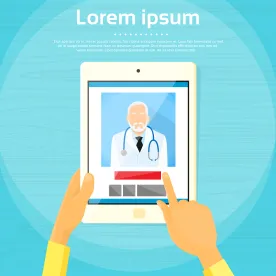Telemedicine providers rejoice: Medicare will cover new virtual care services starting January 1, 2019. The Centers for Medicare and Medicaid Services (CMS) just published the final rule for the 2019 Physician Fee Schedule, introducing a new code: Virtual Check-Ins, officially titled “Brief Communication Technology-Based Service” (HCPCS code G2012). This article discusses the new code and explains how it will work.
Medicare Virtual Check-Ins Frequently Asked Questions (FAQs)
- What are Virtual Check-Ins? , Officially titled “Brief Communication Technology-Based Service, e.g. Virtual Check-In.” Virtual Check-In is defined as “Brief communication technology-based service, e.g. virtual check-in, by a physician or other qualified health care professional who can report evaluation and management (E/M) services, provided to an established patient, not originating from a related E/M service provided within the previous 7 days nor leading to an E/M service or procedure within the next 24 hours or soonest available appointment; 5-10 minutes of medical discussion).”
- What Modality is Allowed? CMS stated the code allows “audio-only real-time telephone interactions in addition to synchronous, two-way audio interactions that are enhanced with video or other kinds of data transmission.” (Note: telephone calls that involve only clinical staff cannot be billed using HCPCS code G2012 since the code explicitly describes (and requires) direct interaction between the patient and the billing practitioner.) Unfortunately, CMS did not state that pure asynchronous modalities would qualify for this code.
- Is There a Patient Co-Payment for Virtual Check-Ins? Yes, as a Medicare Part B service, the patient is responsible for a co-payment for the service. While several groups asked CMS to eliminate any beneficiary co-payment for the service, CMS explained that it does not have the authority to change the applicable beneficiary cost sharing for most physician services. Providers are cautioned to bill the patient (or the patient’s secondary insurer) for the co-payment, as routine waivers of patient co-payments can present a fraud & abuse risk under the federal Civil Monetary Penalties Law and the Anti-Kickback Statute.
- Is Patient Consent Required? Patient consent is required for this service, due in part to the fact that there is a patient co-pay. CMS stated that written consent is not required; a practitioner can obtain the patient’s verbal consent and note that in the medical record for each billed service (i.e. every time the patient wants to obtain a virtual check-in). This is a disappointing requirement for the patient’s user experience, particularly as CMS could have allowed a process where the patient gave consent once, and the practitioner kept a copy on file.
- Are There Any Patient Restrictions? CMS limits this code to established patients only. With regard to what constitutes an “established patient”, CMS defers to CPT’s definition of this term. CPT defines an established patient as one who has received professional services from the physician or qualified health care professional or another physician or qualified health care professional of the exact same specialty and subspecialty who belongs to the same group practice, within the past 3 years.
- Who Can Deliver Virtual Check-Ins? Virtual Check-Ins can be delivered only by those practitioners authorized to furnish E/M services. This service is meant to describe, and account for the resources involved, when the billing practitioner directly furnishes the virtual check-in. Accordingly, only physicians and qualified health care professionals are allowed to bill for this service.
- Are There Any Frequency Limits? There is no frequency limitation on this code. Indeed, the service might potentially be an excellent fit in behavioral health treatment for specific patients (e.g., assessing suicidal risk), in which case the frequency should not be limited since routine virtual check-ins would be clinically warranted in some cases. CMS will monitor utilization of the code to determine whether or not it will impose a frequency limitation in the future. Even without an express frequency limitation, Virtual Check-Ins, like all other physicians’ services billed under Medicare, must be medically reasonable and necessary to be reimbursed.
- Are There Any Timeframe Limitations? CMS considered and appreciated the comments to remove the timeframe limitations, but ultimately decided to retain them in the code. Of particular disappointment is that CMS retained the “or soonest available appointment” language. CMS agreed that in each individual case, it might be challenging to prove whether or not other appointments were available prior to the visit, especially since beneficiary convenience is also presumably a factor for when appointments are scheduled. However, CMS concluded that as a whole, retaining the language in the code description could help to guard against the potential for abuse that would be present if CMS instead adopted a purely time-based window for bundling of this service.
- If the Virtual Check-In originates from a related E/M service provided within the previous 7 days by the same physician or other qualified health care professional, then the service is considered bundled into that previous E/M service and G2012 would not be separately billable (provider liable). In that event, do not bill either the patient or the Medicare program for that code.
- If the Virtual Check-In leads to an E/M service with the same physician or other qualified health care professional within the next 24 hours or soonest available appointment, then this service is considered bundled into the pre- or post-visit time of the associated E/M service, and therefore, would not be separately billable (provider liable). In that event, do not bill either the patient or the Medicare program for that code.
- What are the Documentation Requirements? There are no service-specific documentation requirements for Virtual Check-Ins (other than documenting the patient’s consent, of course). Documentation for Virtual Check-Ins is consistent with the requirements for other Medicare covered physician services.
- Are There Any Patient Location Requirements? The patient need not be located in a rural area or any specific originating site. The patient can be at home. Providers frustrated with the labyrinthine and narrow Medicare coverage of telehealth services can take comfort in the fact that Virtual Check-Ins are not considered a Medicare telehealth service.
Conclusion
The new code represents a sizeable change to allow providers to efficiently use new technologies to deliver medical care. By reimbursing for virtual check-ins, the new code exemplifies CMS’ renewed vision and desire to bring the Medicare program into the future of clinically-valid virtual care services.




 />i
/>i

